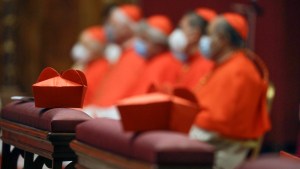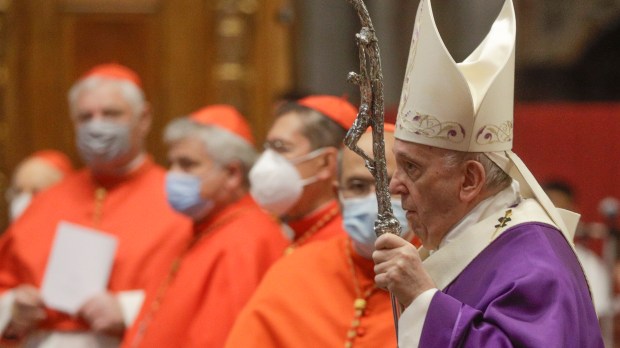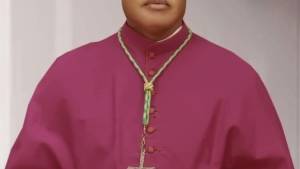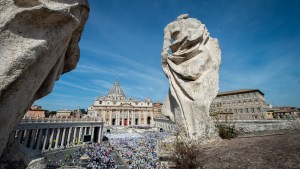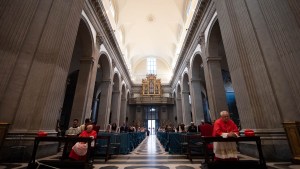Pope Francis has convoked a consistory for August 27, 2022, during which he will create 21 cardinals, including 16 cardinal electors. I.MEDIA offers an analysis in infographics of the state of the college of cardinal electors.
Note that these statistics include the cardinal electors designate—who will not officially receive their rights until the August consistory. This brings to 132 the number of cardinal electors on which the following analysis is based.
By bringing 16 new cardinals into the electoral college, Pope Francis continues to mark the College. Of the 132 called to sit in the pews of the Sistine Chapel in the event of a conclave, Pope Francis has named 83, or 63%.
There are still 38 cardinals under the age of 80 created by Pope Benedict XVI (29%) and only 11 created during the pontificate of John Paul II (8%).
This also means that only 49 of the cardinals (37%) have lived through at least one conclave.
Recall that the age of 80 is the cut-off for being able to vote. Sometimes cardinals are created already over the age of 80, and thus never eligible to vote.
In total (not just electors), John Paul II created 231 cardinals in nine consistories; Benedict XVI created 90 cardinals in five consistories. With those of August, Francis’ number will come to 122.

Youngest class of cardinal electors since 2013
Pope Francis is making the college of cardinal electors one year younger on average with this new group, which has the distinction of being the youngest group of the eight consistories convoked by Pope Francis since the beginning of his pontificate. The 16 cardinal electors are 65.2 years old on average. By comparison, the average age of the cardinal electors in the 2020 consistory was 66.3 and the average age of the 2017 consistory was 72. Now, the 132 cardinal electors have an average age of 71.8.
The youngest cardinal in this class is Italian Giorgio Marengo, who will be 48 at the time of the consistory. This missionary in Mongolia, born on June 7, 1974, dethrones Cardinal Dieudonné Nzapalainga, now 55, who entered the college in 2016 at the age of 49. Giorgio Marengo is also the first cardinal born in the 1970s.
The oldest prelate to enter the college of electors is Archbishop Fernando Vérgez Alzaga, 77. This Spaniard, president of the Pontifical Commission for Vatican City State and president of the Governorate of Vatican City State, will reach the age of 80 on March 1, 2025, at which point he will no longer be able to elect a pope in the event of a conclave.


Europe’s influence continues to decrease slowly
It’s true that Europe is still the continent with the greatest weight in the College. With five new European cardinals, it totals 56 of the 132 cardinal electors, or 42% of the college. Nonetheless, this proportion has tended to decrease after each consistory convoked by Pope Francis.
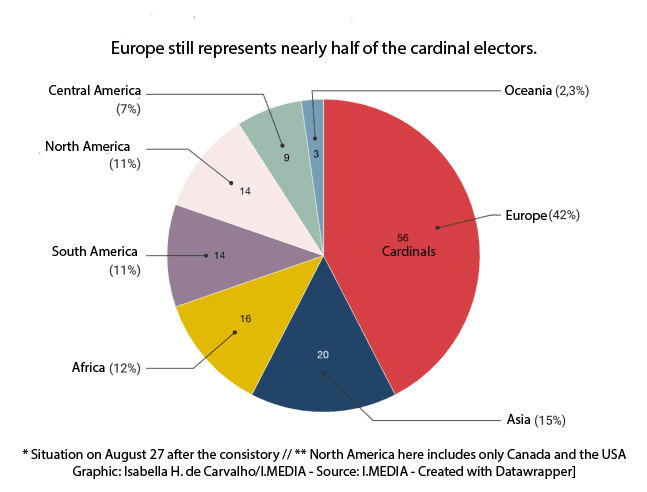
By way of comparison, the chart below only counts the 83 cardinal electors created by Francis. It shows that “only” 37% of the cardinals created by the Argentine Pope are Europeans. For the record, during the 2013 conclave, the college of cardinals was 52% European. The Old Continent has lost 10 percentage points in just under 10 years.
Asia, by contrast, has seen a great increase under the pontificate of the Argentine. The continent now represents 15% of the electoral college, whereas it accounted for only 9% at the last conclave. For comparison, Africa represented 10% in 2013 and counts for 12% today.
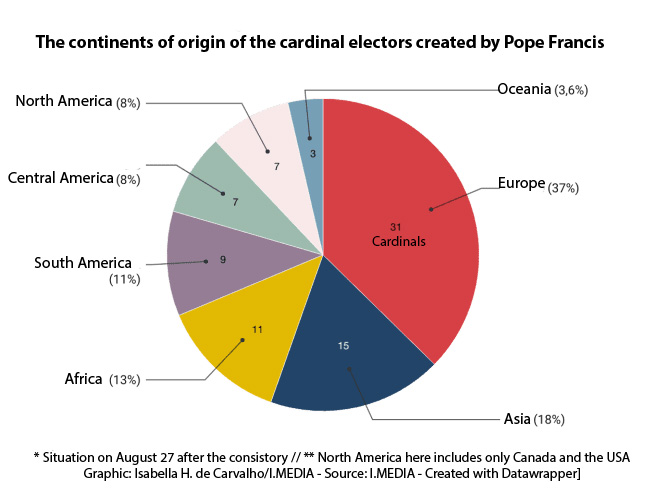
With 21 cardinal electors, Italy is still the country that has—by far—the most representatives in the college. However, its proportion has also been decreasing after each consistory. Italians now represent 16% of the college, whereas in the 2013 conclave, the Peninsula had 28 electors, or nearly a quarter of the college.
With 10 cardinals, the United States is the second largest provider of electors (8%). Spain with 8 cardinals completes the podium of the top three. With 5 cardinals each, France and India are just behind Brazil (6).
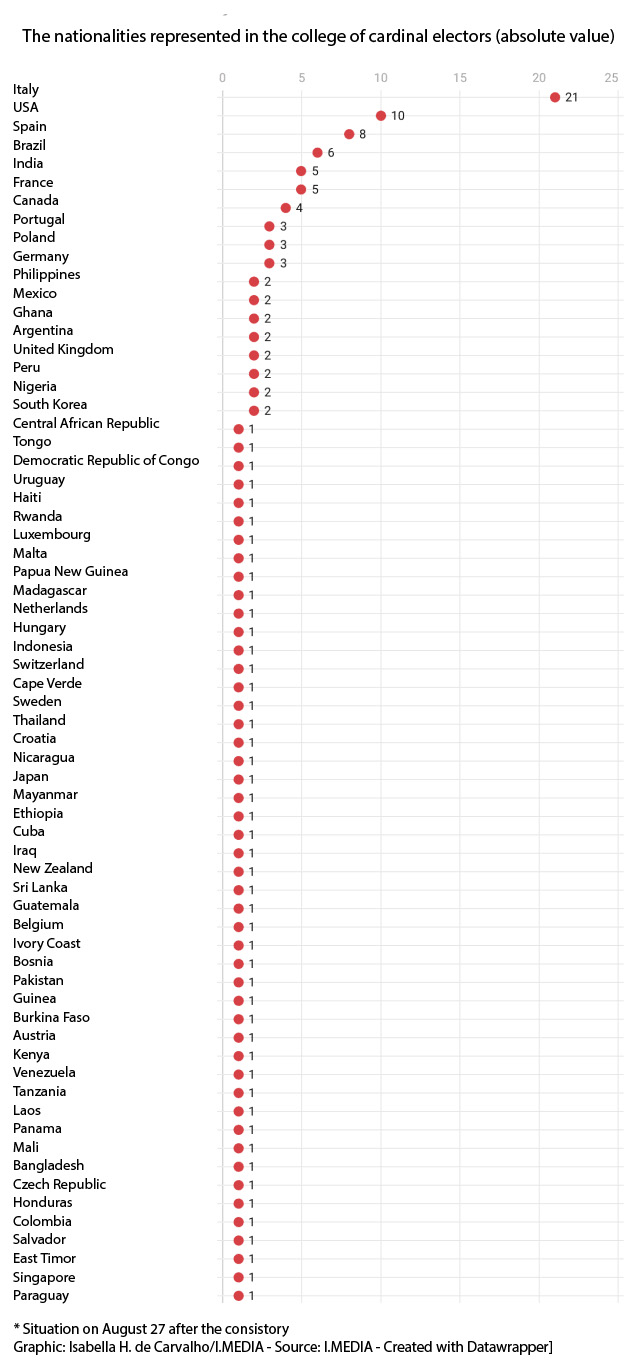
The novelties of this 2022 consistory
Among the new cardinals are prelates whose countries had never given cardinals to the Catholic Church, such as East Timor, with Archbishop Da Silva of Dili, and Singapore, with Archbishop William Seng Chye Goh.
It’s also the first time that Paraguay will have a cardinal on its soil, with Archbishop Adalberto Martínez Flores, 70, Archbishop of Asunción. However, since 2019 there has been a cardinal of Paraguayan nationality, in the person of Cristóbal López Romero, Archbishop of Rabat in Morocco. A Spaniard, he previously lived in Paraguay for several years and acquired the country’s citizenship.
Mongolia had never had a cardinal either. Even though he’s Italian and not Mongolian, the young cardinal-designate Giorgio Marengo has lived in that country for 20 years and will probably remain there.
Finally, this consistory includes the elevation to the cardinal’s purple of the first Dalit in history. This honor falls to the Archbishop of Hyderabad (India), Anthony Poola, who is entering the college of electors. He comes from the Dalit caste—formerly called “untouchables”—whose members often face discrimination.
Absent from this consistory
Pope Francis has once again demonstrated his freedom from the traditional cardinal’s seats in this consistory. In Italy, for example, the patriarch of Venice and the current archbishops of Turin, Naples, Palermo, and Genoa have still not received the cardinal’s biretta.
In the same vein, Pope Francis chose not to elevate the Archbishop of Los Angeles, José Gómez, president of the United States Conference of Catholic Bishops, whose three predecessors were cardinals. On the other hand, he created Cardinal Robert McElroy, Bishop of San Diego, a diocese that is a suffragan of Los Angeles.
As has been the case since the beginning of his pontificate, Pope Francis has not chosen a cardinal from Central Europe—with the exception of Polish Cardinal Konrad Krajewski, who was created a cardinal in 2018 and works in Rome as the Apostolic Almoner.
Finally, some names proposed for the purple have not yet been given the cardinalate by the Argentine pope. Among these surprises, for example, is Charles Scicluna, Archbishop of Malta and assistant secretary of the Congregation for the Doctrine of the Faith. In 2018, the Pope asked him, among other things, to investigate the Karadima case in Chile.
The name of Archbishop Rino Fisichella, president of the Pontifical Council for the New Evangelization since June 2010 and in charge of the organization of the Jubilee of 2025 in Rome, also does not appear in the list of 21 cardinals. However, depending on future developments in the organization chart of the Roman Curia, further appointments are not to be ruled out.
